ASRock Industrial 4X4 BOX-7840U mini-PC Review: AMD Phoenix in an UCFF Avatar
by Ganesh T S on December 28, 2023 8:30 AM ESTSystem Performance: Multi-Tasking
One of the key drivers of advancements in computing systems is multi-tasking. On mobile devices, this is quite lightweight - cases such as background email checks while the user is playing a mobile game are quite common. Towards optimizing user experience in those types of scenarios, mobile SoC manufacturers started integrating heterogenous CPU cores - some with high performance for demanding workloads, while others were frugal in terms of both power consumption / die area and performance. This trend is now slowly making its way into the desktop PC space.
Multi-tasking in typical PC usage is much more demanding compared to phones and tablets. Desktop OSes allow users to launch and utilize a large number of demanding programs simultaneously. Responsiveness is dictated largely by the OS scheduler allowing different tasks to move to the background. The processor is required to work closely with the OS thread scheduler to optimize performance in these cases. Keeping these aspects in mind, the evaluation of multi-tasking performance is an interesting subject to tackle.
We have augmented our systems benchmarking suite to quantitatively analyze the multi-tasking performance of various platforms. The evaluation involves triggering a ffmpeg transcoding task to transform 1716 3840x1714 frames encoded as a 24fps AVC video (Blender Project's 'Tears of Steel' 4K version) into a 1080p HEVC version in a loop. The transcoding rate is monitored continuously. One complete transcoding pass is allowed to complete before starting the first multi-tasking workload - the PCMark 10 Extended bench suite. A comparative view of the PCMark 10 scores for various scenarios is presented in the graphs below. Also available for concurrent viewing are scores in the normal case where the benchmark was processed without any concurrent load, and a graph presenting the loss in performance.
| UL PCMark 10 Load Testing - Digital Content Creation Scores | |||
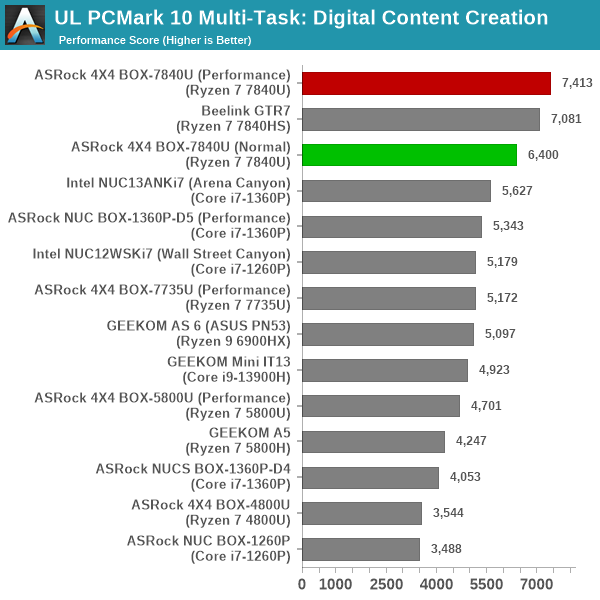
| UL PCMark 10 Load Testing - Productivity Scores | |||
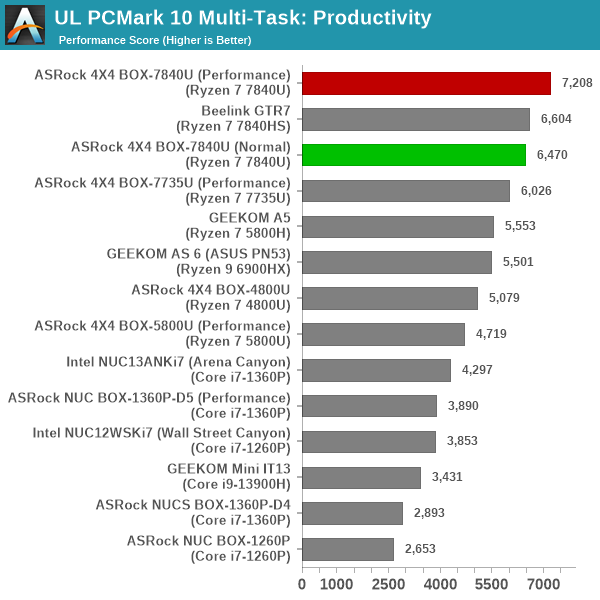
| UL PCMark 10 Load Testing - Essentials Scores | |||
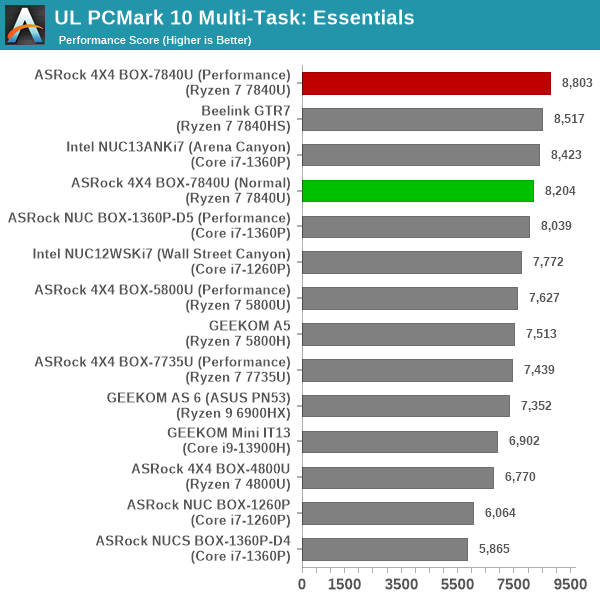
| UL PCMark 10 Load Testing - Gaming Scores | |||
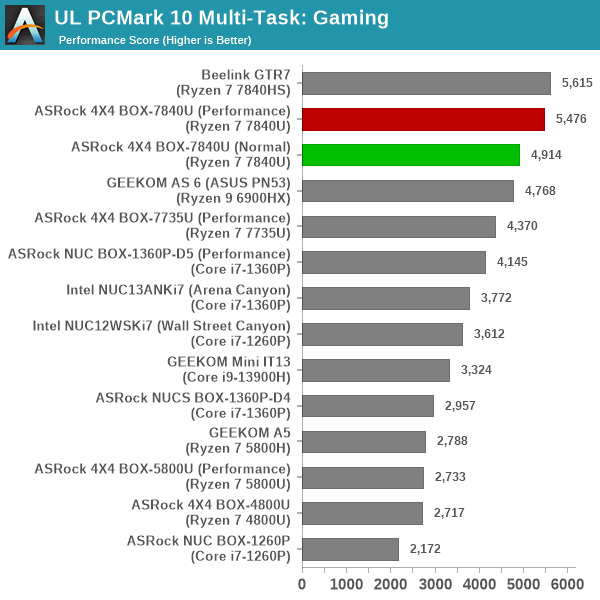
| UL PCMark 10 Load Testing - Overall Scores | |||
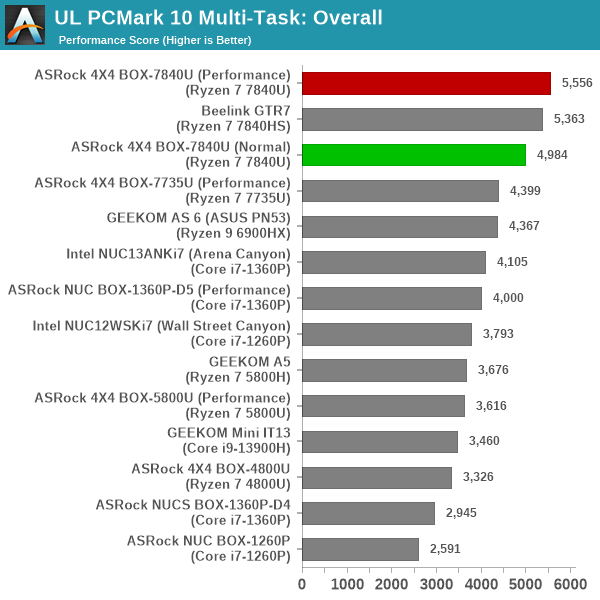
Even at 28W, the Phoenix SoC has plenty of headroom to tackle multiple concurrent demanding workloads triggered by mainstream users (of the type benchmarked by PCMark 10). The 4X4 BOX-7840U configurations already had leading performance in the absence of concurrent loading in most segments. Activating the ffmpeg load reduces the raw score, but the performance loss is less than the competition and the Phoenix systems continue to stay on top.
Following the completion of the PCMark 10 benchmark, a short delay is introduced prior to the processing of Principled Technologies WebXPRT4 on MS Edge. Similar to the PCMark 10 results presentation, the graph below show the scores recorded with the transcoding load active. Available for comparison are the dedicated CPU power scores and a measure of the performance loss.
| Principled Technologies WebXPRT4 Load Testing Scores (MS Edge) | |||
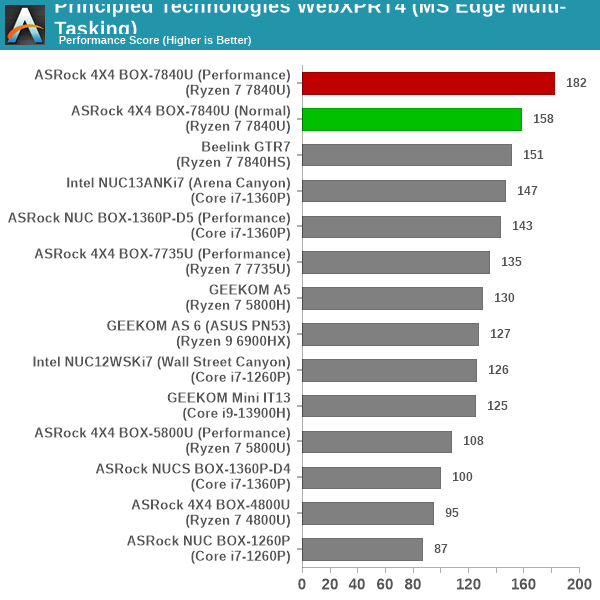
The observations made for the overall PCMark 10 scores continue to hold for WebXPRT 4 also. Interestingly, the handling by Phoenix is good enough to even prop up the systems to the top spot in the presence of the transcoding load despite being in the middle of the pack without the extra load.
The final workload tested as part of the multitasking evaluation routine is CINEBENCH R23.
| 3D Rendering - CINEBENCH R23 Load Testing - Single Thread Score | |||

| 3D Rendering - CINEBENCH R23 Load Testing - Multiple Thread Score | |||
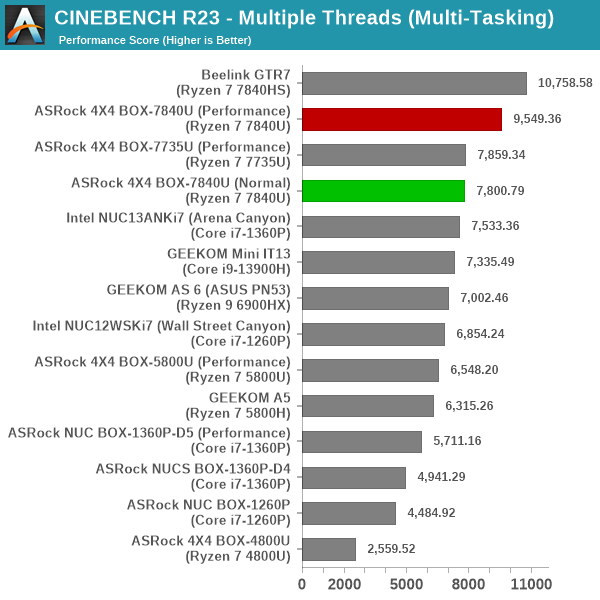
Similar to the web browsing workload, the Intel systems lose their ST performance advantage in the presence of concurrent loading. As a result, the Phoenix systems rise to the top. In the MT version, they retain their top billing despite the drop in the raw scores.
After the completion of all the workloads, we let the transcoding routine run to completion. The monitored transcoding rate throughout the above evaluation routine (in terms of frames per second) is graphed below.
In the above scenario, the transcoding task is supposed to happen in the background. The user should ideally not care about the transcoding performance in that case, but it is still interesting to look into how that varies based on the concurrent load being applied.
| ASRock Industrial 4X4 BOX-7840U (Ryzen 7 7840U @ 28W) ffmpeg Transcoding Rate (Multi-Tasking Test) | |||
| Task Segment | Transcoding Rate (FPS) | ||
| Minimum | Average | Maximum | |
| Transcode Start Pass | 4.5 | 14.5 | 44.5 |
| PCMark 10 | 0 | 12.79 | 44.5 |
| WebXPRT 4 | 4.5 | 12.66 | 22.5 |
| Cinebench R23 | 0 | 13.55 | 42 |
| Transcode End Pass | 3 | 14.65 | 45 |
| ASRock Industrial 4X4 BOX-7840U (Ryzen 7 7840U @ 40W) ffmpeg Transcoding Rate (Multi-Tasking Test) | |||
| Task Segment | Transcoding Rate (FPS) | ||
| Minimum | Average | Maximum | |
| Transcode Start Pass | 5.5 | 17.12 | 51.5 |
| PCMark 10 | 0 | 14.81 | 49 |
| WebXPRT 4 | 6 | 14.72 | 30.5 |
| Cinebench R23 | 2.5 | 15.16 | 59 |
| Transcode End Pass | 6 | 17.03 | 50.5 |
Despite the addition of heavy concurrent loading, we see that the drop in transcoding performance is not too worrisome outside of full saturation regions from the foreground tasks.


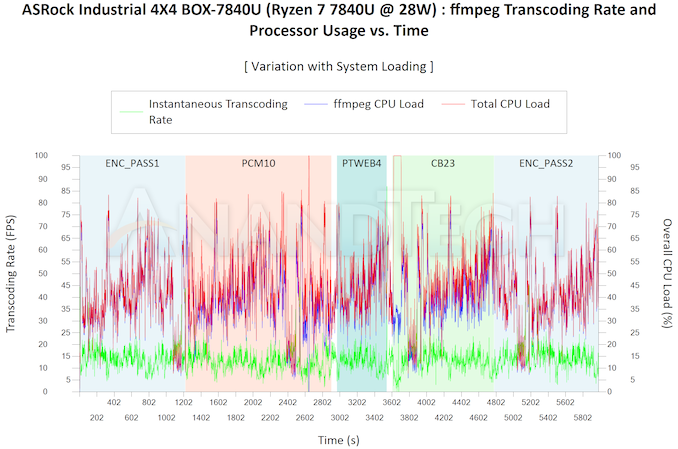
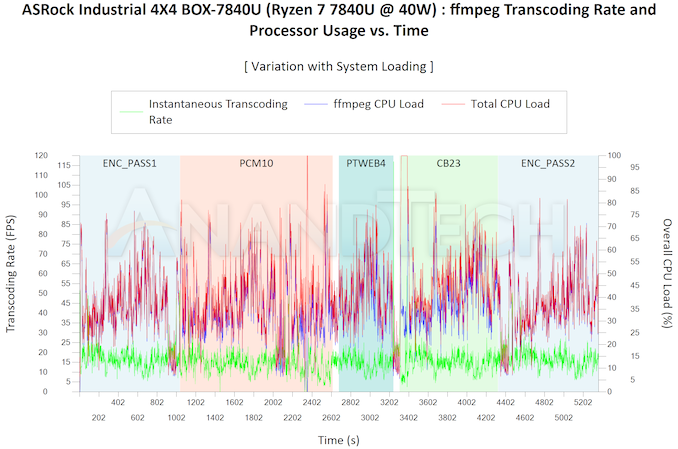








13 Comments
View All Comments
FWhitTrampoline - Sunday, December 31, 2023 - link
Get an Intel Meteor Lake based system instead as that at least has the iGPU compute support ducks in order for Linux via Intel's OneAPI/Associated iGPU Compute API support. On Linux AMD's ROCm/HIP is not supported on AMD's current iGPUs and really that's going to limit any Ryzen APU based systems to Blender Cycles CPU only rendering whereas Intel's Meteor Lake will be able to utilize the iGPU for Blender 3D's GPU accelerated rendering. And even iGPUs have a bit more FP resources than CPUs and Intel's ARC Graphics tile has Ray Tracing units as well with a higher level of hardware feature support than AMD's RDNA3 Ray Tracing IP.haplo602 - Sunday, December 31, 2023 - link
so what is the advantage over a beelink/minisforum/morefine ? except the higher price ?TheinsanegamerN - Tuesday, January 2, 2024 - link
Better support and a website that works? Minisforum's site is held together with duct tape.